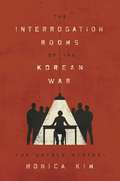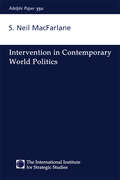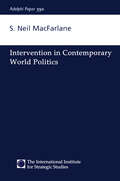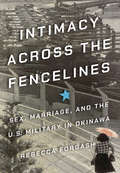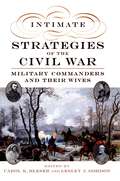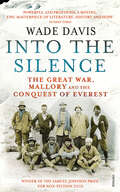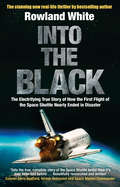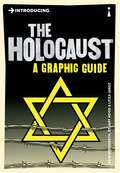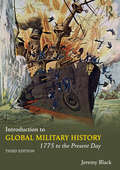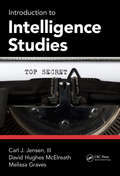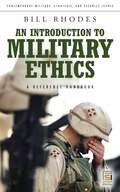- Table View
- List View
The Interrogation Rooms of the Korean War: The Untold History
by Monica KimA groundbreaking look at how the interrogation rooms of the Korean War set the stage for a new kind of battle—not over land but over human subjectsTraditional histories of the Korean War have long focused on violations of the thirty-eighth parallel, the line drawn by American and Soviet officials in 1945 dividing the Korean peninsula. But The Interrogation Rooms of the Korean War presents an entirely new narrative, shifting the perspective from the boundaries of the battlefield to inside the interrogation room. Upending conventional notions of what we think of as geographies of military conflict, Monica Kim demonstrates how the Korean War evolved from a fight over territory to one over human interiority and the individual human subject, forging the template for the US wars of intervention that would predominate during the latter half of the twentieth century and beyond.Kim looks at how, during the armistice negotiations, the United States and their allies proposed a new kind of interrogation room: one in which POWs could exercise their “free will” and choose which country they would go to after the ceasefire. The global controversy that erupted exposed how interrogation rooms had become a flashpoint for the struggles between the ambitions of empire and the demands for decolonization, as the aim of interrogation was to produce subjects who attested to a nation’s right to govern. The complex web of interrogators and prisoners—Japanese-American interrogators, Indian military personnel, Korean POWs and interrogators, and American POWs—that Kim uncovers contradicts the simple story in US popular memory of “brainwashing” during the Korean War.Bringing together a vast range of sources that track two generations of people moving between three continents, The Interrogation Rooms of the Korean War delves into an essential yet overlooked aspect of modern warfare in the twentieth century.
The Interrogation Rooms of the Korean War: The Untold History
by Monica KimA groundbreaking look at how the interrogation rooms of the Korean War set the stage for a new kind of battle—not over land but over human subjectsTraditional histories of the Korean War have long focused on violations of the thirty-eighth parallel, the line drawn by American and Soviet officials in 1945 dividing the Korean peninsula. But The Interrogation Rooms of the Korean War presents an entirely new narrative, shifting the perspective from the boundaries of the battlefield to inside the interrogation room. Upending conventional notions of what we think of as geographies of military conflict, Monica Kim demonstrates how the Korean War evolved from a fight over territory to one over human interiority and the individual human subject, forging the template for the US wars of intervention that would predominate during the latter half of the twentieth century and beyond.Kim looks at how, during the armistice negotiations, the United States and their allies proposed a new kind of interrogation room: one in which POWs could exercise their “free will” and choose which country they would go to after the ceasefire. The global controversy that erupted exposed how interrogation rooms had become a flashpoint for the struggles between the ambitions of empire and the demands for decolonization, as the aim of interrogation was to produce subjects who attested to a nation’s right to govern. The complex web of interrogators and prisoners—Japanese-American interrogators, Indian military personnel, Korean POWs and interrogators, and American POWs—that Kim uncovers contradicts the simple story in US popular memory of “brainwashing” during the Korean War.Bringing together a vast range of sources that track two generations of people moving between three continents, The Interrogation Rooms of the Korean War delves into an essential yet overlooked aspect of modern warfare in the twentieth century.
Intervening in Africa: Superpower Peacemaking in a Troubled Continent (Studies in Diplomacy)
by H. CohenAs the Cold War faded, Ambassador Hank Cohen, President George Bush's Assistant Secretary of State for Africa, engaged in aggressive diplomatic intervention in Africa's civil wars. In this revealing book Cohen tells how he and his Africa Bureau team operated in seven countries in crisis: Angola, Ethiopia, Liberia, Mozambique, Rwanda, Somalia, and Sudan. He candidly characterizes key personalities and events and provides a treasure trove of lessons learned and basic principles for practitioners of conflict resolution within states.
Intervention in Contemporary World Politics (Adelphi series)
by Neil MacfarlaneExamines multilateral interventions in civil conflicts and the evolution of the role of such interventions in world politics. It focuses primarily on the Cold War and post-Cold War eras and the differences between them. It contests the notion that there is an emerging norm of humanitarian intervention in international politics, arguing that political interests remain essential to the practice of intervention.
Intervention in Contemporary World Politics (Adelphi series)
by Neil MacfarlaneExamines multilateral interventions in civil conflicts and the evolution of the role of such interventions in world politics. It focuses primarily on the Cold War and post-Cold War eras and the differences between them. It contests the notion that there is an emerging norm of humanitarian intervention in international politics, arguing that political interests remain essential to the practice of intervention.
Intimacy across the Fencelines: Sex, Marriage, and the U.S. Military in Okinawa
by Rebecca ForgashIntimacy Across the Fencelines examines intimacy in the form of sexual encounters, dating, marriage, and family that involve US service members and local residents. Rebecca Forgash analyzes the stories of individual US service members and their Okinawan spouses and family members against the backdrop of Okinawan history, political and economic entanglements with Japan and the United States, and a longstanding anti-base movement. The narratives highlight the simultaneously repressive and creative power of military "fencelines," sites of symbolic negotiation and struggle involving gender, race, and class that divide the social landscape in communities that host US bases.Intimacy Across the Fencelines anchors the global US military complex and US-Japan security alliance in intimate everyday experiences and emotions, illuminating important aspects of the lived experiences of war and imperialism.
An Intimate History of the Front: Masculinity, Sexuality, and German Soldiers in the First World War
by J. CrouthamelThis eye-opening study gives a nuanced, provocative account of how German soldiers in the Great War experienced and enacted masculinity. Drawing on an array of relevant narratives and media, it explores the ways that both heterosexual and homosexual soldiers expressed emotion, understood romantic ideals, and approached intimacy and sexuality.
Intimate Strategies of the Civil War: Military Commanders and Their Wives
by Carol K. Bleser Lesley J. GordonFrom Robert E. and Mary Lee to Ulysses S. and Julia Grant, Intimate Strategies of the Civil War examines the marriages of twelve prominent military commanders, highlighting the impact wives had on their famous husbands' careers. Carol K. Bleser and Lesley J. Gordon assemble an impressive array of leading scholars to explore the marriages of six Confederate and six Union commanders. Contributors reveal that, for many of these men, the matrimonial bond was the most important relationship in their lives, one that shaped (and was shaped by) their military experience. In some cases, the commanders' spouses proved relentless and skillful promoters of their husbands' careers. Jessie Frémont drew on all of her connections as the daughter of former Senator Thomas Hart Benton to aid her modestly talented husband John. Others bolstered their military spouses in less direct ways. For example, Ulysses S. Grant's relationship with Julia (a Southerner and former slave owner herself) kept him anchored in stormy times. Here, too, are tense and tempestuous pairings, such William Tecumseh Sherman and his wife Ellen--his foster sister before becoming his wife--and Jefferson Davis's fascinatingly complex bond with Varina, further complicated by the hostile rumors about the two in Richmond society. Throughout, these historians paint remarkably intimate portraits of their subjects. Readers will see these famed men in a way that they perhaps never considered: not merely as famous leaders, but as lovers, husbands and fathers.
Intimate Strategies of the Civil War: Military Commanders and Their Wives
by CAROL K. BLESER AND LESLEY J. GORDONFrom Robert E. and Mary Lee to Ulysses S. and Julia Grant, Intimate Strategies of the Civil War examines the marriages of twelve prominent military commanders, highlighting the impact wives had on their famous husbands' careers. Carol K. Bleser and Lesley J. Gordon assemble an impressive array of leading scholars to explore the marriages of six Confederate and six Union commanders. Contributors reveal that, for many of these men, the matrimonial bond was the most important relationship in their lives, one that shaped (and was shaped by) their military experience. In some cases, the commanders' spouses proved relentless and skillful promoters of their husbands' careers. Jessie Frémont drew on all of her connections as the daughter of former Senator Thomas Hart Benton to aid her modestly talented husband John. Others bolstered their military spouses in less direct ways. For example, Ulysses S. Grant's relationship with Julia (a Southerner and former slave owner herself) kept him anchored in stormy times. Here, too, are tense and tempestuous pairings, such William Tecumseh Sherman and his wife Ellen--his foster sister before becoming his wife--and Jefferson Davis's fascinatingly complex bond with Varina, further complicated by the hostile rumors about the two in Richmond society. Throughout, these historians paint remarkably intimate portraits of their subjects. Readers will see these famed men in a way that they perhaps never considered: not merely as famous leaders, but as lovers, husbands and fathers.
An Intimate War: An Oral History of the Helmand Conflict, 1978-2012
by Mike MartinAn Intimate War tells the story of the last thirty-four years of conflict in Helmand Province, Afghani- stan as seen through the eyes of the Helmandis. In the West, this period is often defined through different lenses - the Soviet intervention, the civil war, the Taliban, and the post-2001 nation-building era. Yet, as experienced by local inhabitants, the Helmand conflict is a perennial one, involving the same individuals, families and groups, and driven by the same arguments over land, water and power. This book - based on both military and re- search experience in Helmand and 150 inter- views in Pashto - offers a very different view of Helmand from those in the media. It demonstrates how outsiders have most often misunderstood the ongoing struggle in Helmand and how, in doing so, they have exacerbated the conflict, perpetuated it and made it more violent - precisely the opposite of what was intended when their interventions were launched. Mike Martin's oral history of Helmand under- scores the absolute imperative of understanding the highly local, personal, and non-ideological nature of internal conflict in much of the 'third' world.
An Intimate War: An Oral History of the Helmand Conflict, 1978-2012
by Mike MartinAn Intimate War tells the story of the last thirty-four years of conflict in Helmand Province, Afghani- stan as seen through the eyes of the Helmandis. In the West, this period is often defined through different lenses - the Soviet intervention, the civil war, the Taliban, and the post-2001 nation-building era. Yet, as experienced by local inhabitants, the Helmand conflict is a perennial one, involving the same individuals, families and groups, and driven by the same arguments over land, water and power. This book - based on both military and re- search experience in Helmand and 150 inter- views in Pashto - offers a very different view of Helmand from those in the media. It demonstrates how outsiders have most often misunderstood the ongoing struggle in Helmand and how, in doing so, they have exacerbated the conflict, perpetuated it and made it more violent - precisely the opposite of what was intended when their interventions were launched. Mike Martin's oral history of Helmand under- scores the absolute imperative of understanding the highly local, personal, and non-ideological nature of internal conflict in much of the 'third' world.
Into Africa: The Epic Adventures Of Stanley And Livingstone (Charnwood Large Print Ser.)
by Martin DugardIn 1866 Britain's foremost explorer, Dr David Livingstone, went in search of the answer to an age-old geographical riddle: where was the source of the Nile? Livingstone set out with a large team, on a course that would lead through unmapped, seemingly impenetrable terrain into areas populated by fearsome man-eating tribes. Within weeks his expedition began to fall apart - his entourage deserted him and Livingstone vanished without trace. He would not be heard from again for two years.While debate raged in England over whether Livingstone could be found in the unmapped wilderness of the African interior, James Gordon Bennet, a brash young American newspaper tycoon, hatched a plan to capitalise on the world's fascination with the missing legend. He commissioned his star reporter, Henry Morton Stanley (born John Rowlands in Wales!), to search for Livingstone. Stanley undertook his quest with gusto, filing reports that captivated readers and dominated the front page of the New York Herald for months.INTO AFRICA traces the journeys of Livingstone and Stanley in alternating chapters. Livingstone's is one of trials and set-backs, that finds him alone and miles from civilisation. Stanley's is an awakening to the beauty of Africa, the grandeur of the landscape and the vivid diversity of its wildlife. It is also a journey that succeeds beyond his wildest dreams, clinching his place in history with the famous enquiry: 'Dr Livingstone, I presume?'. In this, the first book to examine the extraordinary physical challenges, political intrigue and larger-than-life personalities of this legendary story, Martin Dugard has opened a fascinating window on the golden age of exploration that will appeal to everyone's sense of adventure.
Into The Silence: The Great War, Mallory and the Conquest of Everest
by Wade Davis‘The price of life is death’ For Mallory, as for all of his generation, death was but ‘a frail barrier that men crossed, smiling and gallant, every day’. As climbers they accepted a degree of risk unimaginable before the war. What mattered now was how one lived, and the moments of being alive. While the quest for Mount Everest may have begun as a grand imperial gesture, it ended as a mission of revival for a country and a lost generation bled white by war. In a monumental work of history and adventure, Davis asks not whether George Mallory was the first to reach the summit of Everest, but rather why he kept climbing on that fateful day.
Into the Black: The electrifying true story of how the first flight of the Space Shuttle nearly ended in disaster
by Rowland WhiteOn 12th April 1981 a revolutionary new spacecraft blasted off from Florida on her maiden flight. NASA’s Space Shuttle Columbia was the most advanced flying machine ever built – the high watermark of post-war aviation development. A direct descendant of the record-breaking X-planes the likes of which Chuck Yeager had tested in the skies over the Mojave Desert, Columbia was a winged rocket plane, the size of an airliner, capable of flying to space and back before being made ready to fly again. She was the world’s first real spaceship.On board were men with the Right Stuff. The Shuttle’s Commander, moonwalker John Young, was already a veteran of five spaceflights. Alongside him, Pilot Bob Crippen was making his first, but Crip, taken in by the space agency after the cancellation of a top secret military space station programme in 1969, had worked on the Shuttle’s development for a decade. Never before had a crew been so well prepared for their mission.Yet less than an hour after Young and Crippen’s spectacular departure from the Cape it was clear that all was not well. Tiles designed to protect Columbia from the blowtorch burn of re-entry were missing from the heatshield. If the damage to their ship was too great the astronauts would be unable to return safely to earth. But neither they nor mission control possessed any way of knowing. Instead, NASA turned to the National Reconnaissance Office, a spy agency hidden deep inside the Pentagon whose very existence was classified. To help, the NRO would attempt something that had never been done before. Success would require skill, pinpoint timing and luck …Drawing on brand new interviews with astronauts and engineers, archive material and newly declassified documents, Rowland White, bestselling author of Vulcan 607, has pieced together the dramatic untold story of the mission for the first time. Into the Black is a thrilling race against time; a gripping high stakes cold-war story, and a celebration of a beyond the state-of-the-art machine that, hailed as one of the seven new wonders of the world, rekindled our passion for spaceflight.*With a foreword by Astronaut Richard Truly*‘Beautifully researched and written, Into the Black tells the true, complete story of the Space Shuttle better than it’s ever been told before.’ Colonel Chris Hadfield, former Astronaut and Space Station Commander‘Brilliantly revealed, Into the Black is the finely tuned true story of the first flight of the Space Shuttle Columbia. Rowland White has magnificently laid bare the unknown dangers and unseen hazards of that first mission … Once read, not forgotten.’Clive Cussler
Into the Fire: An Orphan X Novel (An Orphan X Novel #5)
by Gregg HurwitzTHE GRIPPING NEW SUNDAY TIMES TOP 5 BESTSELLER FROM THE BESTSELLING AUTHOR OF OUT OF THE DARK AND ORPHAN X'STELLAR. GETS BETTER WITH EACH INSTALLMENT'DAILY MAILHE WANTED TO END IT. BUT IT CAN NEVER BE OVER.Evan Smoak - former government assassin, 'Orphan-X', turned white knight of last resort - is hanging up his gun.When he gets one last call.A man, left a package by a murdered cousin, has an assassin on his trail. Easy work for Evan.Except behind the assassin is someone worse. And behind them something darker still.How long can Evan keep standing?How many times can a man step into the fire?'Memorable as hell' James Patterson'A new series character to rival Reacher' Independent
Into Vietnam (SAS Operation)
by Shaun ClarkeUltimate soldier. Ultimate mission. But will the SAS survive a nightmare journey into the tunnel lair of the Viet Cong?
Introducing the Holocaust: A Graphic Guide (Introducing...)
by Stuart Hood Litza Jansz Haim Bresheeth'Excellent ... an astounding amount of material.' Times Educational Supplement Popular culture often portrays the Holocaust as a horrific drama played out between Nazi executioners and ghetto Jewish victims - in short, a single aberration of history. Introducing the Holocaust is a powerful graphic guide that dissolves this stereotype, explaining the causes and its relevance today. It places the Holocaust where it belongs - at the centre of modern European and world history. Haim Bresheeth and Stuart Hood - along with Litza Jansz's outstanding illustrations - bring a unique and unforgettable perspective to how we think about this most dark of shadows on human history.
Introduction to Global Military History: 1775 to the Present Day
by Jeremy BlackThis lucid account of military developments around the modern world begins with the American War of Independence and the French revolutionary wars and continues chronologically to the latest 21st century conflicts. It combines determinedly global coverage with thought-provoking analysis not only of the military aspects of conflict but also its social, cultural, political and economic dimensions and consequences. By placing familiar events alongside the largely unknown, the reader is forced to reassess the standard grand narrative of military history that rests on assumptions of Western cultural and technological superiority. It will be essential reading for students worldwide, whether studying modern military history, modern world history, history and international relations or war and society. This fully updated second edition includes: chapter introductions and conclusions to assist study and revision 'Voices of War' sourced extracts from the field of conflict case studies in each chapter to support the narrative and provoke discussion a 12-page colour map section and over 20 other integrated maps annotated references from the latest publications in the field
Introduction to Global Military History: 1775 to the Present Day
by Jeremy BlackThis lucid account of military developments around the modern world begins with the American War of Independence and the French revolutionary wars and continues chronologically to the latest 21st century conflicts. It combines determinedly global coverage with thought-provoking analysis not only of the military aspects of conflict but also its social, cultural, political and economic dimensions and consequences. By placing familiar events alongside the largely unknown, the reader is forced to reassess the standard grand narrative of military history that rests on assumptions of Western cultural and technological superiority. It will be essential reading for students worldwide, whether studying modern military history, modern world history, history and international relations or war and society. This fully updated second edition includes: chapter introductions and conclusions to assist study and revision 'Voices of War' sourced extracts from the field of conflict case studies in each chapter to support the narrative and provoke discussion a 12-page colour map section and over 20 other integrated maps annotated references from the latest publications in the field
Introduction to Global Military History: 1775 to the Present Day
by Jeremy BlackIntroduction to Global Military History provides a lucid and comprehensive account of military developments around the modern world from the eighteenth century up to the present day. Beginning with the background to the American War of Independence and the French Revolutionary wars and ending with the recent conflicts of the twenty-first century, this third edition combines fully up-to-date global coverage with close analysis not only of the military aspects of war but also its social, cultural, political and economic dimensions and repercussions. The new edition includes a fully revised chapter on conflicts during the eighteenth century, updated coverage of events post-1990 and increased coverage of non-Western conflicts to provide a truly international account of the varied and changing nature of modern military history. Covering lesser-known conflicts as well as the familiar wars of history and illustrated throughout with maps, primary source extracts and case studies, it is essential reading for all students of modern military history and international relations.
Introduction to Global Military History: 1775 to the Present Day
by Jeremy BlackIntroduction to Global Military History provides a lucid and comprehensive account of military developments around the modern world from the eighteenth century up to the present day. Beginning with the background to the American War of Independence and the French Revolutionary wars and ending with the recent conflicts of the twenty-first century, this third edition combines fully up-to-date global coverage with close analysis not only of the military aspects of war but also its social, cultural, political and economic dimensions and repercussions. The new edition includes a fully revised chapter on conflicts during the eighteenth century, updated coverage of events post-1990 and increased coverage of non-Western conflicts to provide a truly international account of the varied and changing nature of modern military history. Covering lesser-known conflicts as well as the familiar wars of history and illustrated throughout with maps, primary source extracts and case studies, it is essential reading for all students of modern military history and international relations.
Introduction to Global Military History: 1775 to the Present Day
by Jeremy BlackNow in its fourth edition, Introduction to Global Military History is an accessible, up-to-date account of modern warfare from the eighteenth century to the present.The book engages with the social, cultural, political and economic contexts of war, examining the causes and consequences of conflict beyond national and chronological boundaries. It challenges the dominant Western-centric, technologically focused view of military history and instead emphasises the ranges of circumstances faced by both Western and non-Western powers and the absence of any one direction of development. The chapters present integrated discussions of land, naval and air conflicts, addressing continuities and the ways in which common experiences affected different spheres. This edition revises the text throughout, has increased focus on the developments of the 2000s and 2010s, and adds a new chapter on the 2020s.Supported by a variety of illustrations, maps and case studies, this study is a valuable resource for students of military history and general readers alike.
Introduction to Global Military History: 1775 to the Present Day
by Jeremy BlackNow in its fourth edition, Introduction to Global Military History is an accessible, up-to-date account of modern warfare from the eighteenth century to the present.The book engages with the social, cultural, political and economic contexts of war, examining the causes and consequences of conflict beyond national and chronological boundaries. It challenges the dominant Western-centric, technologically focused view of military history and instead emphasises the ranges of circumstances faced by both Western and non-Western powers and the absence of any one direction of development. The chapters present integrated discussions of land, naval and air conflicts, addressing continuities and the ways in which common experiences affected different spheres. This edition revises the text throughout, has increased focus on the developments of the 2000s and 2010s, and adds a new chapter on the 2020s.Supported by a variety of illustrations, maps and case studies, this study is a valuable resource for students of military history and general readers alike.
Introduction to Intelligence Studies
by Carl Jensen IiiSince the attacks of 9/11, the United States Intelligence Community (IC) has undergone an extensive overhaul. Perhaps the greatest of these changes has been the formation of the Office of the Director of National Intelligence. As a cabinet-level official, the Director oversees the various agencies of the IC and reports directly to the President. Th
An Introduction to Military Ethics: A Reference Handbook (Contemporary Military, Strategic, and Security Issues)
by Bill RhodesThis comprehensive overview examines the many facets of military ethics as they are applied during times of armed conflict and times of peace.An Introduction to Military Ethics: A Reference Handbook presents the philosophical and conceptual foundations of military ethics, offering an excellent foundation for exploration and discussion of these issues. It focuses first on the 2,500-year legacy of the "just war theory" and its application through history. It then moves to the application of that tradition in the modern era, showing how acts of terrorism by nonstate participants require a new theory and way of thinking about when and how armed force can be justifiably employed. Further, the author analyzes how new theories might alter the fundamental identity of traditional defensive military forces. The book also addresses peacetime ethical issues, such as gender integration and the role of religion in the military. The book is essential reading for military officers and students, as well as those policymakers who confront decisions about how to deploy military force during the War on Terror.
